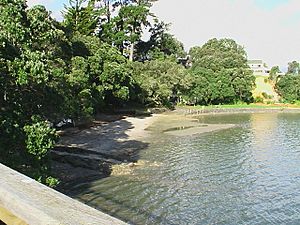Beach Haven, New Zealand facts for kids
Quick facts for kids
Beach Haven
|
|
|---|---|
|
Suburb
|
|

View of the beach at Beach Haven from Beach Haven Wharf
|
|
| Country | New Zealand |
| Local authority | Auckland |
| Electoral ward | North Shore ward |
| Local board | Kaipātiki Local Board |
| Established | 1922 |
| Area | |
| • Land | 367 ha (907 acre) |
| Population
(June 2023)
|
|
| • Total | 10,730 |
| Postcode(s) |
0626
|
| Ferry terminal(s) | (Beach Haven Wharf) |
| Hospitals(s) | (Beach Haven Hospice) |
|
|
||
Beach Haven is a suburb located on the North Shore in Auckland, New Zealand. It's on the western side of the North Shore, right by the Upper Waitematā Harbour. It used to be a small area with holiday homes called baches, but now it's a popular place for families and young people.
Contents
Geography of Beach Haven
Beach Haven is found on the western part of Auckland's North Shore. It sits along the eastern shores of the Upper Waitematā Harbour. A southern part of Beach Haven is a residential area known as Kauri Park.
History of Beach Haven
Long ago, before European settlers arrived, the Beach Haven area was covered in thick native bush. This included large pōhutukawa trees, ferns, and giant kauri trees. Māori tribes lived in this area.
In 1844, the land was sold to the government. Early European settlers arrived in the 1860s. By the 1880s, Beach Haven was a popular summer spot. Many people from the city would travel across the harbour for holidays.
Historically, Beach Haven and its neighbour Birkdale were known for their market gardens. These gardens grew fresh produce for Auckland. Beach Haven also had sawmills and holiday homes.
In 1923, a company bought and surveyed the land near where the wharf is today. They called it the Beach Haven Estate, promoting it as a beautiful place by the water.
After the Auckland Harbour Bridge was built in 1959, more houses were built. This changed Beach Haven from a rural area into the urban suburb we see today.
People of Beach Haven
Beach Haven covers about 3.67 square kilometres. As of 2023, it has an estimated population of about 10,845 people. This means there are about 2,955 people living in each square kilometre.
The population has grown steadily over the years. In 2023, there were slightly more females than males. The average age of people in Beach Haven was 35.4 years. About 22% of the people were under 15 years old.
Beach Haven is a diverse community. People from many different backgrounds live here. The main ethnic groups include European (Pākehā), Māori, Pasifika, and Asian New Zealanders. Most people speak English.
Many people in Beach Haven identify as having no religion, while a good number are Christian. There are also people who follow other religions like Hinduism, Islam, and Buddhism.
How Beach Haven is Managed
Beach Haven is part of the Auckland Council. It falls under the North Shore ward and the Kaipatiki Local Board. These groups help manage local services and decisions for the area. Before 2010, Beach Haven was part of the North Shore City Council.
For national elections in New Zealand, Beach Haven is part of the Northcote electorate.
Things to Do and See in Beach Haven
Beach Haven has a main shopping area with different shops. You can find a French cafe, bakeries, a post office, a gym, and a police community office. There are also several preschools and a primary school. Churches in the area include Anglican, Catholic, and Mormon.
Beach Haven is surrounded by many lovely beaches perfect for swimming. One of the most beautiful is Charcoal Bay, located in the Waitematā Harbour.
The Beach Haven Wharf is a very popular spot. The first wharf was built here in 1887. It was known for many years as the Birkdale wharf.
Shepherds Park is the biggest park in Beach Haven. It has a 1.6-kilometre walking track through native bush. The park also offers facilities for squash, bowling, and tennis. It has fields for rugby and soccer and is home to the Birkenhead United AFC football club.
Beach Haven has good bus connections to Takapuna and Auckland's city centre. In 2013, a new ferry service started from Beach Haven Wharf to the city. This service helps reduce traffic and makes it easier for people to travel.
Beach Haven is also known for House of Chocolate. This is a working chocolate factory that started in 1999.
Community Life in Beach Haven
The community in Beach Haven is active. A local garden project, supported by the council, was completed in 2015.
There was a community effort to save the old Beach Haven Methodist Church. This church was built by the community in one day in 1939. A trust wanted to replace it with housing for people with disabilities. The community group and the trust are working together to find a way to keep the church building.
The local policing project in Kaipatiki won a national award in 2013 for its community work.
The hip hop artist Sir T. grew up in Beach Haven and often mentions the area in his music.
Homes in Beach Haven
Beach Haven has a mix of different types of homes. You can find original holiday homes (baches), bungalows from the 1950s and 1960s, apartments, and modern homes near the water. Many houses even have direct access to the waterfront.
Schools in Beach Haven
Beach Haven has two primary schools:
- Beach Haven School is for students in years 1-6.
- Kauri Park School is also a primary school.
Both schools are proud of their diverse student populations.
The local high school for students in Beach Haven is Birkenhead College. It is located between Beach Haven and Birkdale.


